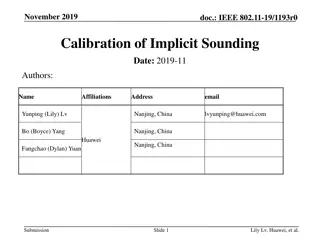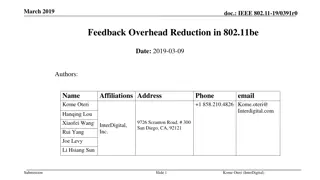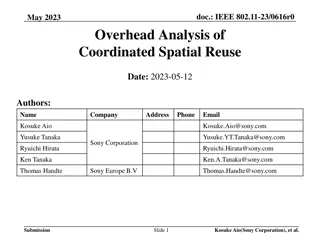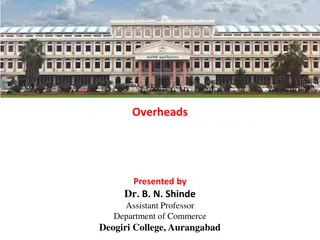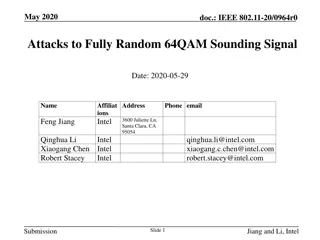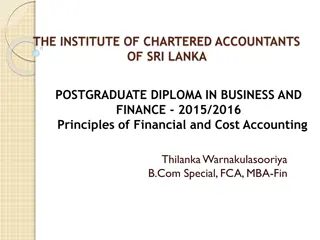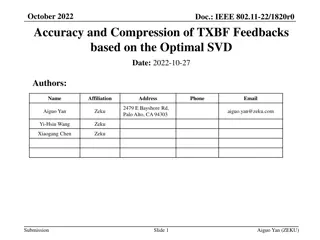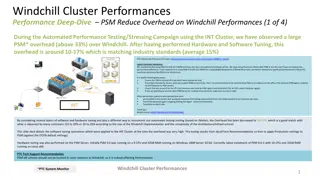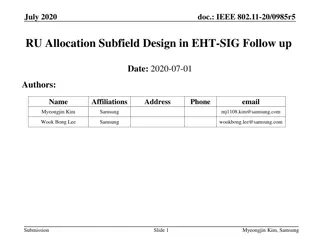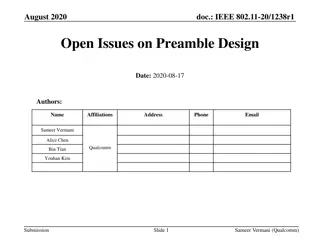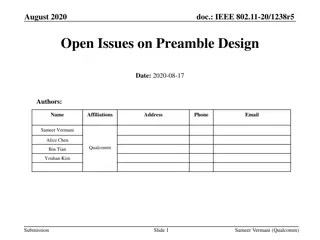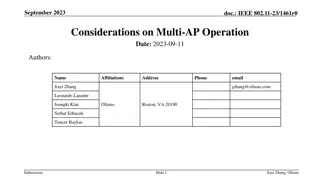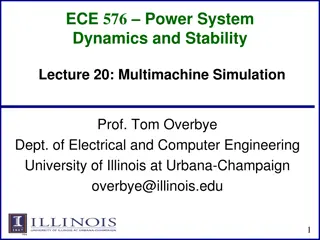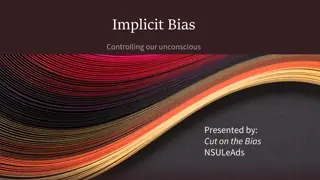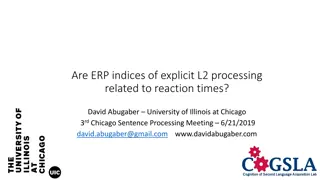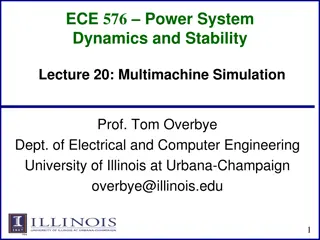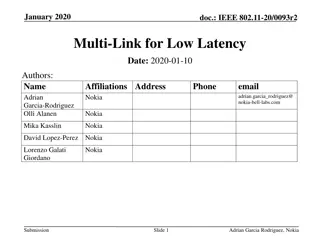Implicit Sounding Analysis in IEEE 802.11: Overhead Reduction
The document discusses implicit sounding as an efficient alternative to traditional sounding protocols in IEEE 802.11 standards. Implicit sounding aims to minimize the airtime overhead by requesting information from Beamformee to estimate channels, potentially reducing explicit feedback requirements. The analysis covers different sounding schemes and their impact on system performance and efficiency.
Download Presentation

Please find below an Image/Link to download the presentation.
The content on the website is provided AS IS for your information and personal use only. It may not be sold, licensed, or shared on other websites without obtaining consent from the author. Download presentation by click this link. If you encounter any issues during the download, it is possible that the publisher has removed the file from their server.
E N D
Presentation Transcript
July 2019 doc.: IEEE 802.11-19/1268 Implicit sounding overhead analysis Date: 2019-07-14 Authors: Name Affiliation Address Email Sigurd Schelstraete Quantenna Communications 1704 Automation Parkway, San Jose, CA 95131, USA sschelstraete@quantenna.com Imran Latif ilatif@quantenna.com Debashis Dash ddash@quantenna.com Huizhao Wang hwang@quantenna.com Submission Slide 1 Sigurd Schelstraete, Quantenna
July 2019 doc.: IEEE 802.11-19/1268 Introduction Current 802.11 sounding protocols are based on sounding followed by explcit sounding feedback These explicit protocols can take up a lot of airtime Implicit sounding [1, 2] has been suggested as a way to reduce sounding overhead This submission provides an analysis of overhead incurred by different sounding schemes Submission Slide 2 Sigurd Schelstraete, Quantenna
July 2019 doc.: IEEE 802.11-19/1268 Current sounding protocols SU-type feedback MU-type feedback Submission Slide 3 Sigurd Schelstraete, Quantenna
July 2019 doc.: IEEE 802.11-19/1268 Content of HE compressed Beamforming frame Only for MU-type feedback Exact number of bits depends on channel dimensions Nc: #feedback streams Ns: #sounded streams Na: # angles in V-matrix compression (see next slide) b , b : compression parameters Submission Slide 4 Sigurd Schelstraete, Quantenna
July 2019 doc.: IEEE 802.11-19/1268 Values of Na Number of angles (Na) as function of Nc and Nr 802.11ax only defines up to Nr= 8 802.11be may go up to Nr= 16 Submission Slide 5 Sigurd Schelstraete, Quantenna
July 2019 doc.: IEEE 802.11-19/1268 Implicit sounding Implicit sounding has been proposed as an alternative Beamformer requests NDP from Beamformee This allows estimation of the BFee BFer channel Derive BFer BFee channel from this estimate Requires calibration at AP side [3] Potential to reduce airtime overhead Basic scheme: Submission Slide 6 Sigurd Schelstraete, Quantenna
July 2019 doc.: IEEE 802.11-19/1268 Implicit sounding (2) Can be extended to receive multiple NDPs simultaneously Either multiplexed in MU-MIMO or e.g. tone-interleaved Sounded clients should have similar receive powers If not, multiple successive implicit soundings can still be used Submission Slide 7 Sigurd Schelstraete, Quantenna
July 2019 doc.: IEEE 802.11-19/1268 Additional considerations Power differences between UL and DL Client transmit power can be lower than AP transmit power Could reduce the quality of the channel estimate This can be compensated for by repeating the training signals Submission Slide 8 Sigurd Schelstraete, Quantenna
July 2019 doc.: IEEE 802.11-19/1268 Some examples: overhead vs. frame Submission Slide 9 Sigurd Schelstraete, Quantenna
July 2019 doc.: IEEE 802.11-19/1268 Observations on explicit feedback MU (OFDMA) does not always provide significant improvement for high-dimensional cases OFDMA does not reduce the amount of airtime needed for data transmission When protocol overhead is not dominant, MU sounding feedback does not provide much improvement MU feedback may be worse than SU feedback because of OFDMA inefficiencies in spectrum allocation and padding MU-type feedback is not the ultimate solution for reducing sounding overhead Submission Slide 10 Sigurd Schelstraete, Quantenna
July 2019 doc.: IEEE 802.11-19/1268 Simulation results Numerical examples to estimate time needed for sounding and feedback exchange Assumptions: #sounding streams: 4, 8, 16 NRX: 1, 2, 4 Number of users: 4, 8 Ng: 4 MCS: 2 BW: 80 MHz HE-LTF repeated 4 times for implicit sounding Assume OFDMA for MU-type feedback HE-LTF mode: 2x, GI: 0.8 sec Submission Slide 11 Sigurd Schelstraete, Quantenna
July 2019 doc.: IEEE 802.11-19/1268 Four different schemes simulated SU sounding MU sounding Implicit (successive) Implicit (MU) Submission Slide 12 Sigurd Schelstraete, Quantenna
July 2019 doc.: IEEE 802.11-19/1268 Numerical data sounding and feedback absolute time Submission Slide 13 Sigurd Schelstraete, Quantenna
July 2019 doc.: IEEE 802.11-19/1268 Analysis Explicit sounding takes up significant airtime for high- dimensional channels Not much difference between successive SU soundings and MU-type sounding (OFDMA) for high-dimensional channels Even with repeated training symbols, airtime taken by implicit sounding is an order of magnitude lower Submission Slide 14 Sigurd Schelstraete, Quantenna
July 2019 doc.: IEEE 802.11-19/1268 Numerical data sounding and feedback relative overhead What really matters is the total airtime overhead of channel sounding Needs to be considered in network context. Different scenarios will yield different answers To allow us to quantify overhead, we use the following metric: Sounding overhead relative to single frame transmission ?????????+????????? ?????????+?????????+?????? overhead if we sounded the channel right before transmission and used the results only for precoding of the subsequent frame Not necessarily directly representative of network overhead, but allows quantitative comparison between sounding schemes Slide 15 Submission Sigurd Schelstraete, Quantenna
July 2019 doc.: IEEE 802.11-19/1268 Numerical data sounding and feedback relative overhead (2) Data Submission Slide 16 Sigurd Schelstraete, Quantenna
July 2019 doc.: IEEE 802.11-19/1268 Analysis Overhead is extremely high for high-dimensional channels (8 or 16 sounded streams) Overhead of implicit channel sounding is significantly lower Even low enough to allow per-packet sounding Submission Slide 17 Sigurd Schelstraete, Quantenna
July 2019 doc.: IEEE 802.11-19/1268 Conclusions Implicit channel sounding offers significant potential for sounding overhead reduction Proposal: Add Implicit sounding as an optional sounding mechanism for reducing sounding overhead Maintain Explicit sounding as the mandatory mechanism for backwards compatibility Submission Slide 18 Sigurd Schelstraete, Quantenna
July 2019 doc.: IEEE 802.11-19/1268 Straw Poll Do you agree to add Implicit Channel Sounding as an optional sounding mechanism in 802.11be? Submission Slide 19 Sigurd Schelstraete, Quantenna
July 2019 doc.: IEEE 802.11-19/1268 References [1] MU sounding improvements, IEEE 802.11-18/1191 [2] Implicit Channel Sounding in IEEE 802.11, IEEE 802.11-19/0768 [3] Implicit Channel Sounding in IEEE 802.11 (Feasibility Study), IEEE 802.11-19/0767 Submission Slide 20 Sigurd Schelstraete, Quantenna


